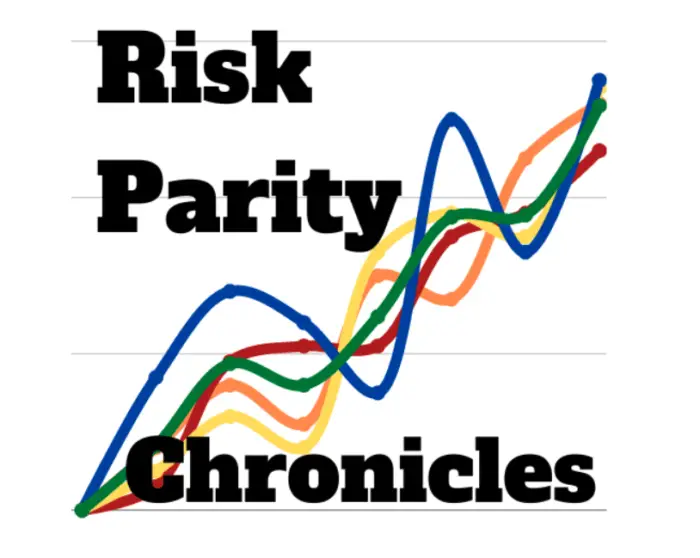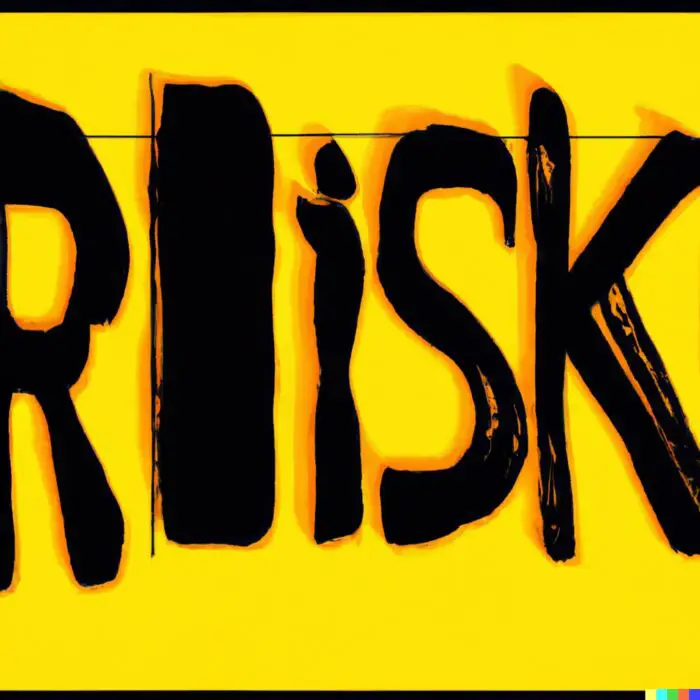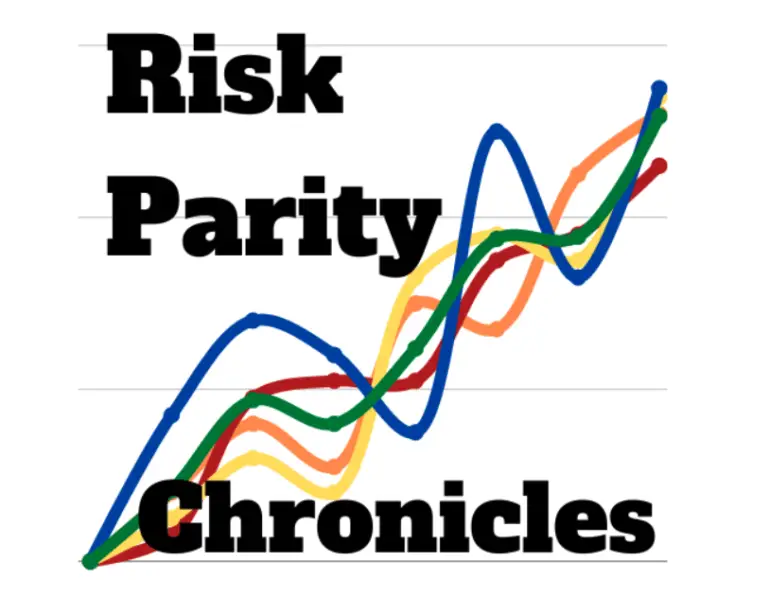I’m thrilled to have Justin of Risk Parity Chronicles join us once again to share his personal portfolio, thoughts, life experiences and lessons learned along the way as we continue our “How I Invest” series on Picture Perfect Portfolios.
Justin’s first contribution “Risk Parity Investing Strategies” as part of the “Investing Legends” series was one of my favourite posts and I feel like this time around we’re getting to know him better as he opens up about his journey as an investor.

RPC Bio
I started investing in 2006 when my wife was pregnant with our first child – I think it was a kind of male “nesting” instinct as I realized I would have to provide for the little guy on my measly grad student stipend.
I read a lot, found it pretty interesting, and started with just maybe $100 a month in a brokerage account.
I got my first real job soon after, and it came with a 401k, so that is when I actually had some money to use.
The GFC happened right after and, although it was a big loss in percentage terms, I really didn’t have that much to lose.
My interest grew gradually, and then probably around 2016 or so I learned about Financial Independence and started getting really intentional about savings and investing.
My wife and I were already pretty good savers at that time, so it was more just about learning how to be better investors.
I read a lot, listened to a lot of podcasts, and pushed my knowledge in all sorts of new directions.
Then around 2020, I learned about Risk Parity, which as I have written about before, I was already kind of doing even before I knew the vocabulary and larger context behind it. I decided to chronicle my journey as I plunged deeper into the world of RP, hence the name.
Hey guys! Here is the part where I mention I’m a travel content creator! This How I Invest interview is entirely for entertainment purposes only. There could be considerable errors in the data I gathered. This is not financial advice. Do your own due diligence and research. Consult with a financial advisor.
Risk Parity Portfolio | How I Invest With Justin Of Risk Parity Chronicles

These asset allocation ideas and model portfolios presented herein are purely for entertainment purposes only. This is NOT investment advice. These models are hypothetical and are intended to provide general information about potential ways to organize a portfolio based on theoretical scenarios and assumptions. They do not take into account the investment objectives, financial situation/goals, risk tolerance and/or specific needs of any particular individual.
Risk Parity Chronicles Greatest Influences
Who were your greatest influences as an investor when you first started to get passionate about the subject?
How have your views evolved over the years to where you currently stand?
If you had to recommend a handful of resources (books, podcasts, white-papers, etc) to bring others up to speed with your investing worldview what would you recommend?

The first book that really impacted me was Burton Malkiel’s Random Walk Down Wall Street and I still consult it these days, as it’s the text I assign for the Investing class I teach.
My inclination towards low cost indexing, my knowledge that I’m not going to outsmart the market, and my belief in the mostly Efficient Market all come from that.
The next most impactful is one that I never hear anyone else mention, but it’s really good: Asset Allocation by Roger Gibson (you can read my review here).
This was my introduction to portfolio construction, target allocation, rebalancing, and thinking in terms of portfolios, not separate assets.
Nowadays, it’s a lot of podcasts: Risk Parity Radio, Rational Reminder, GestaltU (ReSolve Riffs), MacroHive, and Meb Faber.
I also listen to Animal Spirits for market news and humor, and then Paula Pant and ChooseFI for mindset and motivation.
I sprinkle in some white papers and the like more focused on Risk Parity.
There is so much in this category to talk about that it’s probably just easier to provide this link to the resources page on my site and then this list of Top 10 resources on Risk Parity.

Real Life Events That Shaped Risk Parity Chronicles
Aside from investing influences, what real life events have molded your overall views as an investor?
Was it something to do with the way you grew up?
Taking on too much risk (or not enough) early on in your journey/career as an investor?
Or just any other life event or personality trait/characteristic that you feel has uniquely shaped the way you currently view yourself as an investor.
Education.
Travel.
Work Experience.
Volunteering.
A major life event.
What has helped shape the type of investor you’ve become today?
My father died when I was in high school and left behind what was at the time a pretty solid chunk of money.
My mother, though, really felt guilty and overwhelmed by the inheritance, so didn’t really manage it well, then made a disastrous decision to buy a business, which collapsed within about three years.
I went from a pretty stable upper middle-class path at age 15 to one where I was paying my own way through college and on food stamps within about five years.
I’m not glorifying those times and don’t mean to imply I still didn’t have a lot of privilege to drawn on, but I think it did make me mature pretty quickly and face the reality of my situation.
It sort of didn’t matter if I was bitter at my mother for what happened, I had to figure things out quickly so I could pay my rent.
I graduated college with some debt, paid it off pretty quickly and then lived pretty modestly for most of my 20s.
I didn’t make much as I traveled around the world (Japan, SE Asia, Central America, Europe, and then did a stint as a Peace Corps volunteer in Zimbabwe), but kept my head above water.
Looking back, that experience was pretty formative – I got used to being on a budget and not really collecting “stuff,” so that even when I started making a legit salary, I never raised my expectations beyond what I had as a mid-20s backpacker.

What Risk Parity Chronicles Wish He Knew Earlier
Imagine you could have a three hour conversation with your younger self.
What would you tell the younger version of yourself in order to become a better investor?
Something that you know now that you wish you knew back then.

I think of that tale of George Washington (or whomever, I am pretty sure the story has been attached to a lot of people) where he said that if he had ten hours to chop down a tree, he’d spend the first nine sharpening the ax.
If I had three hours, I’d probably spend the first 2 hour and 50 minutes just going over compound interest.
As a younger investor, I understood compounding at a certain level, but now that my portfolio is much bigger, I REALLY understand it.
You can literally just wake up and see a one-day jump in the portfolio that is bigger than the total I was able to save for all of 2004, for example.
In my younger days, I used my brokerage accounts as a kind of reserve savings account, and though I am sure I had some good reasons at the time for selling a bit of XYZ stock, I would now recommend selling blood or something before ever selling shares.
I’d probably spend all the time with my younger self just going over time value of money calculations.
I know it wouldn’t be exciting, but maybe that would be effective.

RPC Risk Parity Portfolio
Let’s pop the hood of your portfolio.
What kind of goodies do we have inside to showcase?
Spill the beans.
How much do you got of this?
Why did you decide to add a bit of that?
If you’d like to go over every line-item you can or if would be easier to break your portfolio into categories or quadrants that’s another route worth considering.
When do you anticipate this portfolio performing at its best?

Interesting question for me – the name is Risk Parity Chronicles but I’m still in the accumulation stage, so my own portfolio now isn’t really risk balanced.
Right now, my target allocations are 84% equities, 10% fixed-income and 6% alts.
I do plan on transitioning to a properly constructed RP portfolio when I enter the decumulation stage in about 8 to 12 years (depends on where my kids decide to go to college!).
What exactly it will be is unclear, and it’s what I’m basically testing with the site.
So maybe I should explain it this way, by showing what I have now and what I am tentatively thinking about in 2032.
I have a glidepath worked out to get me from here to there, as well:
RPC Glidepath Portfolio: Now vs 2032
| STYLE | FUND | NOW | 2032 |
| US Large Blend | Mostly SWPPX and VTI; some UPRO | 27 | 15 |
| US Sm Cap Value | Mostly VIOV, with some AVUV. Tiny bit of TNA | 20 | 10 |
| US Growth | Mostly VUG, with a little TQQQ | 13 | 0 |
| International | VXUS, supplemented by AVDV and VWO. | 18 | 10 |
| Equity Real Estate | DFREX, VNQ and some DRN | 6 | 0 |
| Direct/Semi-direct RE | Rental property, Groundfloor, FundRise | 0 | 20 |
| Extended/LT Bonds | Mainly EDV, with some TMF | 10 | 20 |
| Commodities | Mainly PDBC, also BCIM and TAGS | 4 | 5 |
| Gold | GLDM | 1 | 5 |
| Managed Futures | DBMF, will add more as they become available | 1 | 10 |
| Cash/ST Bonds | 0 | 5 |
- I do use some embedded leverage ETFs now and will continue to use some in the decumulation stage, but in pretty small nominal amounts and decreasing leverage every year in decumulation. More of the equity sleeve will transition to low vol, utilities, and the like over time.
- I have a portion devoted to REITs now, but after my big expose, I’m basically going to stop buying any more. I will transition towards more and more actual real estate, including what I think of as semi-direct ways to access deals, especially Groundfloor, FundRise and Peer Street.
- I’ve just gotten into managed futures recently, and see a lot of potential. I’m proceeding cautiously for now, but I could be up at 10% by retirement, or it may just be 5, or it may be 15.
- The future portfolio will undoubtedly be different than what I have here, but it’s basically two parts equities, one part fixed income, one part real estate and one part alternatives.

RPC Investing Skills and Knowledge Required
What kind of investing skills (trading, asset allocation, investor psychology, etc) are necessary to become good at the style of investing you’re pursuing?
Is there a certain type of knowledge, experience and/or personality trait that gives one an advantage running this type of portfolio?
I think you have to be willing to stick with the numbers you establish ahead of time instead of getting caught up in what’s hot now, and if you’re the kind of person who jumps from this to that, then a risk-balancing approach may not be good for you.
In a risk parity portfolio, there is always going to be something doing awfully, and there is always just the temptation to cut out that part.
That makes sense on some level.
But the idea is that asset classes come around, and when a part of your portfolio looks to be really in the dumps, it’s actually the time to get excited about buying more of it (as long as your logical for having it n the first place is sound!).

RPC More Conservative and Aggressive Portfolio
What would be a toned down version of your portfolio?
Something that’s a bit watered down.
Conversely, what would be a more aggressive version of your portfolio, if someone were willing to take on more risk for a potentially greater reward?
A great thing about risk parity is that the portfolio can remain the same at the macro allocation level, you just add or decrease leverage within the asset allocations.
There is one version of a Risk Parity portfolio (the RPC Stability) with no leverage and an expected standard deviation in the 8 range.
It has pretty meager expected returns (around 5.5%), but hey, that’s what you get with stability.
I can also use roughly the same framework but add in 100% leverage and get the RPC Growth, with a standard deviation closer to 17% and returns around 10%.
RP allows you a pretty easy way of just sliding your leverage up or down according to your tastes, without radically changing the macro composition, if at all.

Risk Parity Chronicles Greatest Strength/Weakness As An Investor
What do you feel is your greatest strength as an investor?
What is something that sets you apart from others?
Conversely, what is your greatest weakness?
Are you currently trying to address this weakness, prevent it from easily manifesting or simply doubling down on what it is that you’re great at?

I would say my biggest strength is knowing that I don’t know very much and can’t predict anything.
For a long time I would do that never-ending game where you think “ok, prices are up, so the Fed is likely to raise interest rates, which will make my bonds lose value but then the Bundesbank is likely to respond by X which will then trigger Y and so I will buy Z thai morning.”
But I’ve realized that I can never and will never get it right, and though I may hear professionals sounding confident about the order of consequences, it’s not the best approach for me.
I keep going back to that part in Morgan Housel’s book where he talks about different market participants all playing different games than you are, with different priorities, different resources, different skills, etc.
I guess I have realized what “my game” is: long-term oriented, risk balanced portfolios that prioritize stable perpetual withdrawal rates.
That knowledge helps save me a lot of FOMO and a lot of stress reaching for things that aren’t part of my situation.
My weakness is just my math skills.
I sometimes read these papers and I literally would do better if the paper were in Romanian, since at least I took Spanish in high school and Romanian is a Latin language, meaning I could maybe understand one-tenth of 1%.
That’s still better than some of the papers where the mathematical notation really gets going. I get lost with those.
I’m trying to get better, but I don’t exactly know where to start.
I think we get too much Math as young people, then not nearly enough when we’re older.

Risk Parity Chronicles Agrees/Disagrees With
What’s something that you believe as an investor that is not widely agreed upon by the investing community at large?
On the other hand, what is a commonly held investing belief that most in the industry would agree with that rubs you a bit differently?
Ooooh… a few:
- I hate intentional Dollar Cost Averaging, and I’ve waded into quite a few battles (on Twitter and elsewhere) over that in the past. I call it a form of market timing, which drives people crazy.
- I’m very much in the “Dividends are Irrelevant” camp, and that’s a tricky side to be on at least when you’re talking to average investors.
- I have yet to ever see a persuasive argument for TIPS. They do not seem to actually protect against inflation. People just sort of look at the name, and think, “oh, these will work” but have they ever?
- There is also a lot of push back against embedded leverage ETFs by some, but I use them and they have done exactly what I have expected them to do. I can hear some readers grumbling, so I’ll say, “Yes – I know about volatility drag!” I’m interested in using assets like UPRO and TQQQ in portfolios where their inherent risk is balanced by other assets.

What Risk Parity Chronicles Wants To Learn More About
What’s a subject area in investing that you’re eager to learn more about?
And why?
If you knew more about that particular topic would it influence the way you’d construct your portfolio?
I guess just adding asset classes to the ones I feel comfortable with. Ray Dalio says we should be on the lookout for 15 or so uncorrelated asset classes, but I’m way short of that.
So my next frontier would be some of the hedge-fund type strategies that go beyond index ETFs: global systematic macro, long volatility strategies, tail risk protection, the type of things that pop up frequently on Faber’s podcast or some episodes of GestaltU.
I’m planning on taking a closer look at tail risk protection next, and that may be something I implement later on in the decumulation phase.
If I can come up with a coherent strategy for left tail risk, then I might have better protection for embedded leverage ETFs in the portfolio.

Anti-Risk Parity Chronicles Portfolio
What would be the ultimate anti-Risk Parity Chronicles portfolio?
Something you’d never own unless you were duct-taped to a chair as a hostage?
What about this portfolio is repulsive to you?
Conversely, if you were forced to Steel Man it, what would potentially be appealing about the portfolio to others?
What is so alluring about it?
Probably 50% big tech and then 30% High Yield Corporates and 20% TIPS and then calling it Risk Parity – it’s the last part that would get my goat the most!
The big tech only for equities would be hard for me: chasing returns of the past ten years, super high valuations, low profitability (all things considered), and no factor exposure.
Not for me.
And then for the supposedly “safe” side you’d have the corporates which would perform more like equities when you wanted them to behave differently.
And then TIPS – useless.
If I had to offer the Steel Man argument: “Just look at how big tech has been doing! Corporate Bonds are just like Treasuries, but with higher yields! And if we get crazy inflation again and equities/bonds both have positive correlation with each other as they head downward, then TIPS will be there to save us.”
I think another part of the argument would probably be some killer backtest, probably with a 2010 to 2021 time frame.

Connect with Risk Parity Chronicles Blog and Social Media
I write over at riskparitychronicles.com, with a goal of two posts per week. I’m also active on Twitter at @rp_chornicles and re-post my blog pieces there, if you want to follow. Thanks, Sam, for the opportunity to share my thoughts!

Nomadic Samuel Final Thoughts
I want to personally thank Justin of Risk Parity Chronicles for taking the time to participate in the “How I Invest” series by contributing thoughtful answers to all of the questions!
If you’ve read this article and would like to be a part of the interview series feel free to reach out to nomadicsamuel at gmail dot com.
That’s all I’ve got!
Ciao for now!
Important Information
Investment Disclaimer: The content provided here is for informational purposes only and does not constitute financial, investment, tax or professional advice. Investments carry risks and are not guaranteed; errors in data may occur. Past performance, including backtest results, does not guarantee future outcomes. Please note that indexes are benchmarks and not directly investable. All examples are purely hypothetical. Do your own due diligence. You should conduct your own research and consult a professional advisor before making investment decisions.
“Picture Perfect Portfolios” does not endorse or guarantee the accuracy of the information in this post and is not responsible for any financial losses or damages incurred from relying on this information. Investing involves the risk of loss and is not suitable for all investors. When it comes to capital efficiency, using leverage (or leveraged products) in investing amplifies both potential gains and losses, making it possible to lose more than your initial investment. It involves higher risk and costs, including possible margin calls and interest expenses, which can adversely affect your financial condition. The views and opinions expressed in this post are solely those of the author and do not necessarily reflect the official policy or position of anyone else. You can read my complete disclaimer here.






